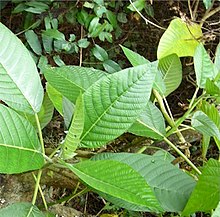Dendrocnide meyeniana
This article needs additional citations for verification. (May 2022) |
| Lipa | |
|---|---|

| |
| Scientific classification | |
| Kingdom: | Plantae |
| Clade: | Tracheophytes |
| Clade: | Angiosperms |
| Clade: | Eudicots |
| Clade: | Rosids |
| Order: | Rosales |
| Family: | Urticaceae |
| Genus: | Dendrocnide |
| Species: | D. meyeniana
|
| Binomial name | |
| Dendrocnide meyeniana | |
| Synonyms | |
|
Laportea meyeniana Warb. | |
Dendrocnide meyeniana or the poisonous wood nettle is a species of tree in the family Urticaceae, native to the thickets and secondary forests of Taiwan and the Philippines. It is called Bazyuru in Taiwan.[1] It is commonly referred to as the lipa tree, but more specifically lipang kalabaw or, more rarely, apariagua.[2] The plant is named bulan-bulan in the Iloilo province and other areas with Bisayan languages.[2]
The city of Lipa, Batangas in the Philippines is named after the lipa tree. Locals distinguish it primarily by the short irritant hairs[3] on its twigs.
It is referred to as the lipa tree ("puno ng lipa" in Tagalog) or lipang kalabaw ("carabao lipa")[3] to distinguish it from Fleurya interrupta, a shrub locally named lipang aso ("dog lipa").[3] The distinction between lipang kalabaw and lipang aso is descriptive, referring to their heights.
Medicinal importance
The poisonous wood nettle may cause acute dermatitis when the skin gets into to contact with the stinging hairs on its leaves.[1]
In Philippine traditional medicine, the tree's sap is prepared as a drink for improving the production of breast milk. Its roots and leaves can also be used as a diuretic.[4]
References
- ^ a b Ya-Ting Chang; Jiann-Jong Shen; Wen-Rou Wong; Hung-Rong Yen (2009). "Alternative Therapy for Autosensitization Dermatitis". Chang Gung Med J. 32 (6): 668–673. CiteSeerX 10.1.1.628.6388. PMID 20035647.
- ^ a b "Lipa". STUARTXCHANGE. Retrieved 4 May 2022.
- ^ a b c Castro, Irma Remo (2006). A Guide to Families of Common Flowering Plants in the Philippines. UP Press. p. 176. ISBN 978-971-542-525-4. Retrieved 3 May 2022.
- ^ Williams, Cheryll (1 July 2012). Medicinal Plants in Australia Volume 3: Plants, Potions and Poisons. Rosenberg Publishing. p. 57. ISBN 978-1-925078-07-7. Retrieved 3 May 2022.
External links
 Media related to Dendrocnide meyeniana at Wikimedia Commons
Media related to Dendrocnide meyeniana at Wikimedia Commons
